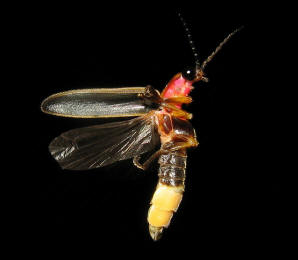Classification
Photinus ignitus is a nocturnal firefly that is
characterized by its bioluminescence (Cratsley & Lewis, 2005).
Most people know this organism by its common name, firefly or
lightning bug. The taxonomy for this organism is as
follows (ADW, 2013):
Domain – Eukarya
Kingdom – Animalia
Phylum – Arthropoda
Class - Insecta
Order – Coleoptera
Family – Lampyridae
Genus – Photinus
Species - Photinus
ignitus

Figure 1. A phylogenetic tree displaying the
largest and most diverse suborder of beetles, Polyphaga.
Elateriformia is the infraorder that Photinus ignitus
belongs to. The superfamilies are in bold (Cantharoidea is the
superfamily that Photinus ignitus falls in). The
families are above the superfamily (Photinus ignitus is
part of the Lampyridae family).

Figure 2. A morphological
phylogenetic tree
shown in the research article by Branham & Wenzel. The tree shows the difference in photic signals
produced among the many species of fireflies. These photic
signals are used to elicit courtship and pair formation among the
fireflies. Photinus ignitus falls under signal system
II, which is when one sex, usually the male, flies around and displays a
species-specific signal that is then answered by the opposite sex
with their own species-specific response. The closest related
organism shown here on this tree is Photinus meteoralis
(Branham & Wenzel, 2002).
The reason for classification!
 Domain: Eukarya
Domain: Eukarya
There are a vast amount of organisms under the domain eukarya.
To be classified as eukaryotic, an organism must have cells that
contain a membrane bound nucleus, as well as other structures
enclosed within membranes, called organelles. Another organism
that is placed uder this category is the
Coprinopsis atramentaria (tippler's bane).
 Kingdom: Animalia
Kingdom: Animalia
Organisms in the kingdom animalia are all multicellular and have
some type of skeletal support. Animals are heterotrophic,
meaning they obtain their food by ingesting complex organic
substances for nutrition. You will see some type of skeletal
support in all animals as well as cells that are specialized for
particular functions. Animals reproduce sexually. Take a
look at another animal,
Hapalochlaena lunulata ( the greater blue-ringed octopus).
 Phylum: Arthropoda
Phylum: Arthropoda
The characteristics of arthropods include having segmented bodies
and jointed appendages. As for skeletal support, they possess a
chitinous exoskeleton that is shed periodically as the arthropod
grows. The phylum arthropoda has a true coelom and are
bilaterally symmetrical. Arthropods are protostomes, which
means that the mouth develops before the anus in embryonic
development. A well-known, dangerous arthopod that should be checked out
in more detail is
the
Lactrodectus sp. (black widow spider).
 Class: Insecta
Class: Insecta
Insects are the most diverse of all animal groups. Along with
the three main body parts, insects also have three pairs of legs.
Each insect has two pairs of wings. Compound eyes and complex
mouth parts are present in this class. Insects undergo
metamorphosis and generally all have a small body size. There
are more species of insects than there are species of all other
animals combined. Take a glance at another species that belongs to
this diverse group,
Aeshna sitchensis (Zigzag Darner dragonfly).
 Order: Coleoptera
Order: Coleoptera
Coleoptera is Greek for “sheathed wing.” Beetles have two
pairs of wings, the top pair (elytra) being enlarged and thick for
protection of the delicate wings underneath. The name
'Coleoptera' commonly signifies beetles (The Free Dictionary, 2013). Check out this unique species
Pelidnota punctata (grapevine beetle).
 Family: Lampyridae
Family: Lampyridae
Lampyridae is use to describe a group of beetles, most of them being
commonly named
the firefly. The beetles in this group have elongated bodies.
The wing coverings (elytra) mentioned in Order: Coleoptera are not
as hard and thick when compared to other
beetles. Lampyridae contains many nocturnal species that have
bioluminescence organs (Merriam-Webster, 2013). Another interesting species to read about is
Photinus pyralis (firefly).
 Genus:
Photinus
Genus:
Photinus
Photinus refers to rover fireflies. Photinus beetles emit
signals or patterns of light to attract their mates. The
organ that emits the light covers the last three posterior segments
on the ventral side. The
Photinus marginellus (firefly) is a
species that fits these qualities.
 Species:
Photinus ignitus
Species:
Photinus ignitus
The scientific name of Photinus ignitus literally means
"rover of fire", refering to the flashing glows made during the
night. Photinus ignitus is a species that is nocturnal and can
produce bioluminescent flashes for a variety of reasons. They
inhabit the northeastern part of the United States, where they
prefer the scenery of marshes. Photinus ignitus
contains steriodal pyrones that give them an unpalatable taste,
deterring most predators.
